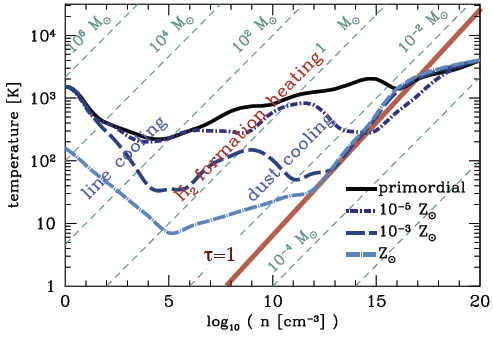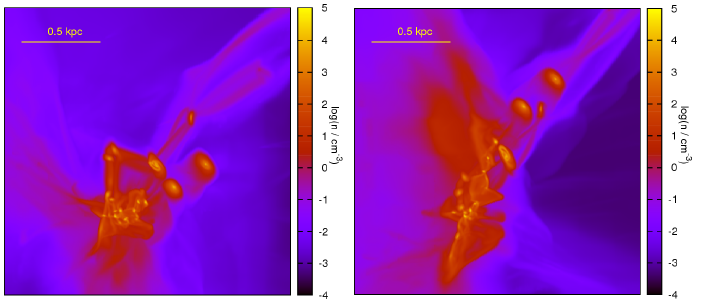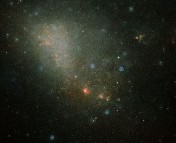Title: On the formation of very metal-poor stars: The case of SDSS J1029151+172927
Authors: Ralf Klessen, Simon Glover, Paul Clark
First Author’s Institution: Zentrum für Astronomie der Universität Heidelberg, Institut für Theoretische Astrophysik
One of the primary reasons I am interested in star formation is because it is connected to virtually every other area of astronomy, from cosmology to chemical enrichment to stellar evolution to extragalactic astronomy. This paper by Klessen et al. demonstrates the key importance of understanding how stars form, particularly in the early Universe. The paper examines a single star – the extremely metal-poor halo star SDSS J1029151+172927 (this lengthy nomenclature indicates that it is an object from the Sloan Digital Sky Survey with celestial coordinates of 10 hours, 29 minutes, 15.1 seconds in right ascension and +17 degrees, 29 arcminutes, and 27 arcseconds in declination) – and uses a combination of theoretical considerations and observational constraints to make a wide-reaching prediction about star formation in the early Universe. This remarkable star, which Anna discussed in this astrobite, was recently found to have one of the lowest metallicities ever reported, about 10-4 to 10-5 Z¤; “metallicity” refers to the amount of metals, or elements heavier than hydrogen and helium, present, so SDSS J1029151+172927 has a factor of 10,000 to 100,000 less carbon, oxygen, and other metals than the Sun! Since the average metallicity of gas (which then forms stars) increases as the Universe evolves, this star is thus thought to be extremely old, representing a population of stars that formed less than a billion years after the Big Bang.
The IMF
The large-scale characteristics of star formation are often discussed in terms of the Initial Mass Function (IMF), which describes how mass is distributed amongst a population of forming stars (see also this astrobite, and this one, and this one, and several others for more about the IMF). For example, a stellar population with a “top-heavy” IMF has a higher proportion of massive stars as compared to low-mass stars, while a population with a “steep” IMF has most of the mass concentrated into lower-mass stars. IMFs are generally parameterized in terms of one or more power laws, and the “steepness” refers to the magnitude of the power law exponent. The first generation of stars – called “population III”, or Pop III – is thought to have had a very top-heavy IMF, while younger populations and currently forming stars seem to exhibit a steeper IMF. When did the transition between these two IMFs occur, and what physical processes might have mediated such a “massive” change? Clearly, the level of chemical enrichment of the gas plays an important role, as Pop III stars formed from primordial gas (i.e. only hydrogen and helium), while subsequent generations collapsed from clouds that had already been enriched with heavier elements fused in the cores of these Pop III stars and released into the interstellar medium as they exploded in supernovae. At some point, then, the star-forming gas became sufficiently metal-enriched such that lower mass stars became more commonly formed, and observing low-mass, metal-poor stars can place constraints on the level of metallicity at which this occurred.
A Thermodynamic Perspective
While star formation is a complicated process that comes down to a battle between the self-gravity of gas and outward forces such as pressure gradients, turbulence, and magnetic fields, the emergent form of the IMF seems to be purely controlled by the thermodynamic properties – i.e. the heating and cooling processes – of the gas. One efficient and simple way to describe the thermodynamics of any gas is via an equation of state, which is an equation relating macroscopic characteristics (such as pressure and density) of a system. For a power-law equation of state of the form P = nγ, where P is the pressure and n the number density of the gas, the gas is cooling-dominated (temperature is a decreasing function of density) for γ < 1 and heating-dominated (temperature is an increasing function of density) for γ > 1. Thus γ = 1 marks a transition point at which fragmentation – and therefore star formation – occurs. Detailed physical models can be used to predict the temperature-density relation for gas of different metallicities, and the dip on a given curve where this relation changes from decreasing to increasing (i.e. where γ = 1) marks the location of star formation, as shown in Figure 1. Furthermore, the Jeans mass, which is the mass of a gas cloud collapsing to form a star, also depends on temperature and density, and lines of constant Jeans mass appear as diagonal lines on the same plot. Thus, one can simply read off the characteristic mass of stars formed from such a plot by estimating which line of constant Jeans mass passes through the dip, and therefore infer how steep the IMF is (a top-heavy IMF has a higher characteristic mass than a steep IMF).

Figure 1. Theoretical curves of equilibrium temperature vs. number density for gas of various metallicity; the dark blue lines of 10-3 and 10-5 Z¤ bracket the region occupied by metal-poor stars such as SDSS JJ1029151+172927. The dips in the curves mark the transitions at which fragmentation, and thus star formation, is likely to occur. Lines of constant Jeans mass are diagonal dotted lines on the plot. Low-mass, low-metallicity stars form with a characteristic mass less than 1 M¤. (Figure based on calculations from Omukai et al. (2005)).
Distinguishing between two physical models
But what physical processes cause the observed dips in the temperature-density plots? The two most relevant to the current discussion are (1) metal-line cooling (radiation from metal atoms that were excited by collisions), which is effective at low densities (if the density is too high, collisions will de-excite the atoms before they can radiate), and (2) dust cooling, which occurs at higher densities where the dust can most effectively absorb and re-radiate some of the energy of the gas. These two regimes are indicated on the figure, and it is immediately clear that, for the low metallicity (10-3 to 10-5 Z¤) gas involved in the formation of the second generation of stars, the line cooling scenario leads to Jeans masses of 10-100 M¤, while the dust cooling dips line up with Jeans masses much less than a solar mass. The star SDSS J1029151+172927, which has a mass of about 0.65 M¤, has such a low metallicity that it is thought to have formed in the generation of stars immediately following Pop III; the above considerations and Figure 1 suggest that it likely formed via dust-induced fragmentation. If stars like this are common, the authors argue that dust cooling is the mechanism responsible for the transition from a top-heavy to a steep IMF.
One caveat: the authors assume (based on predictions and observational frequency) that extremely metal-poor stars like SDSS J1029151+172927 are fairly prevalent, and thus that they represent the surviving members of a primitive stellar population having a relatively steep IMF. They stress the need to find more of these stars, and suggest the galactic bulge as an environment in which they can likely be found. If this assumption proves to be correct, we have certainly come a long way toward understanding the physical processes involved in the formation of some of the first objects formed in the Universe.





Trackbacks/Pingbacks